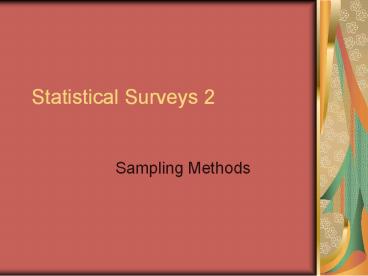Statistical Surveys 2 - PowerPoint PPT Presentation
Title:
Statistical Surveys 2
Description:
Statistical Surveys 2 Sampling Methods Sampling techniques A random sample is a sample drawn in such a way that each element of the population has a chance of being ... – PowerPoint PPT presentation
Number of Views:632
Avg rating:3.0/5.0
Title: Statistical Surveys 2
1
Statistical Surveys 2
- Sampling Methods
2
Sampling techniques
- A random sample is a sample drawn in such a way
that each element of the population has a chance
of being selected. - A random sample is likely to be representative of
the population.
3
(No Transcript)
4
Simple Random Sample
- A simple random sample is a sample that is
selected in such a way that each member has the
same chance of being included in the sample. - This method is best suited to a reasonably small
sample frame. It becomes tedious time-consuming
if the population is large.
5
Systematic Random Sample
- Starting at a random point, and sampling every
nth individual (such as every 15th person on the
school roll). - This method is more convenient for a large
population than the simple random sample. - This method is likely to give a sample which is
representative of the population
6
Stratified Random Sample
- In a stratified random sample we first divide the
population into groups which are called strata.
Then a sample is selected from each strata in
proportion to the size of the group. The
collection of all samples from all strata gives
the stratified random sample.
7
(No Transcript)
8
Quota sample
- A quota sample is like a stratified sample,
except that the sample may or may not be chosen
in a random way. - In a quota sample, a researcher keeps sampling
until they have enough of each category being
investigated. - Eg all age groups in the NZ health survey
9
Cluster Sample
- In cluster sampling the whole population is first
divided into geographical groups called clusters.
Each cluster is representative of the population.
Then a random sample of clusters is selected.
Finally a random sample is taken from each of the
selected clusters.
10
Convenience sampling
- The sample is taken from the easiest part of the
population to reach. - That sample may or may not be representative of
the population.
11
Self-selected sampling
- The sample is open to anyone and people can
decide whether to be part of it. - It is very likely that a self-selected sample
will be biased.































